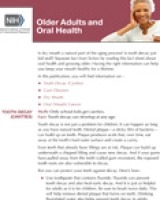Tooth Decay
Overview
Tooth decay begins when bacteria in your mouth make acids that attack the tooth’s surface (enamel). This can lead to a small hole in a tooth, called a cavity. If tooth decay is not treated, it can cause pain, infection, and even tooth loss.
People of all ages can get tooth decay once they have teeth—from childhood through the senior years.
Young children are at risk for “early childhood caries,” sometimes called baby bottle tooth decay. This severe tooth decay starts in the baby’s front teeth and extends to the back teeth.
Because many older adults experience receding gums, which allows decay-causing bacteria in the mouth to come into contact with the tooth’s root, they can get decay on the exposed root surfaces of their teeth.
Back to topCauses
When decay-causing bacteria come into contact with sugars and starches from foods and drinks, they form an acid. This acid can attack the tooth’s enamel, causing it to lose minerals.
When a tooth is repeatedly exposed to acid, such as when you frequently consume food or drink high in sugar and starches, the enamel continues to lose minerals. A white spot may appear where minerals have been lost. This is a sign of early decay.
Tooth decay can be stopped or reversed at this point. Enamel can repair itself by using minerals from saliva and fluoride from toothpaste or through the application of fluoride by a dentist or dental hygienist. If more minerals are lost than can be restored, the enamel weakens and eventually breaks down, forming a cavity.
Back to topSymptoms
In early tooth decay, there are not usually any symptoms.
As tooth decay advances, it can cause a toothache (tooth pain) or tooth sensitivity to sweets, hot, or cold. If the tooth becomes infected, an abscess, or pocket of pus, may form, causing pain, facial swelling, and fever.
Back to topDiagnosis
Tooth decay can be found during a regular dental check-up. Tooth decay signs include white, brown, or black staining on the tooth. If the decay is more advanced, it may form a hole, or cavity. The dentist can also check the teeth for soft or sticky areas or take an x-ray, which can show decay.
Back to topTreatment
If tooth decay is still in its early stages, before a hole (cavity) forms, the dentist can apply fluoride to reverse the decay.
Dentists commonly treat cavities by filling them. A dentist will remove the decayed tooth tissue and then restore the tooth by filling it with a filling material.
Back to topHelpful Tips
Here are some things you can do to prevent tooth decay:
- Use fluoride, a mineral that can prevent tooth decay from progressing, and even reverse, or stop, early tooth decay. You can get fluoride by:
- Brushing with a fluoride toothpaste.
- Drinking tap water that has fluoride.
- Using fluoride mouth rinse.
- Have a good oral hygiene routine. Brush teeth twice a day with a fluoride toothpaste and regularly clean between teeth with floss or another interdental (between-the-teeth) cleaner.
- Make smart food choices that limit sugary drinks and foods high in sugars and starches. Eat nutritious and balanced meals and limit snacking.
- Do not use tobacco products, including smokeless tobacco. If you currently use tobacco, consider quitting.
- See a dentist for regular check-ups and professional cleanings.
A note to parents: Visit A Healthy Mouth for Your Baby and The Tooth Decay Process: How to Reverse It and Avoid a Cavity, to learn how to care for your baby’s and children’s teeth, including information on when to start using fluoride toothpaste. In addition, when your child’s permanent (second) teeth come in, talk to your dentist about sealants. They cover the chewing surfaces of teeth and can help prevent decay.
Back to topAdditional Resources
- A Healthy Mouth for Your Baby [PDF - 2 Pages]
A print-friendly version of NIDCR's A Healthy Mouth for Your Baby. - Children's Oral Health
Information from the Centers for Disease Control and Prevention (CDC) for parents and caregivers about how to prevent tooth decay in children. - Take Care of Your Child's Teeth
Information from Healthfinder.gov on steps you can take to protect your child's teeth from tooth decay. - Adult Oral Health
Information and oral health tips from the CDC. - Oral Health for Older Americans
Information and tips from the CDC on how older adults can maintain their oral health. - Women’s Oral Health
Provides information on oral health and pregnancy and common oral health problems. - National Maternal and Child Oral Health Resource Center
This organization aids in the development and promotion of effective strategies to improve oral health service delivery systems for mothers and their children. - MedlinePlus: Tooth Decay
The NIH National Library of Medicine's collection of links to government, professional, and non-profit/voluntary organizations with information on tooth decay.
Related Publications
October 2024


